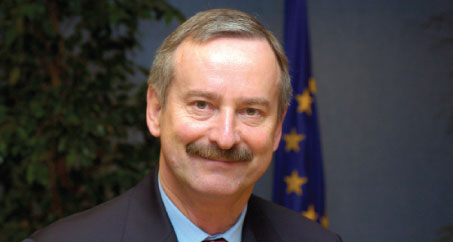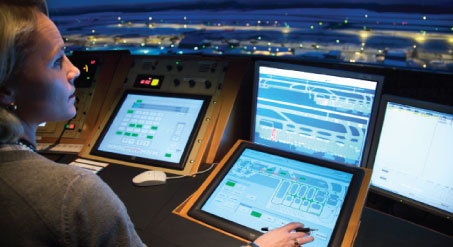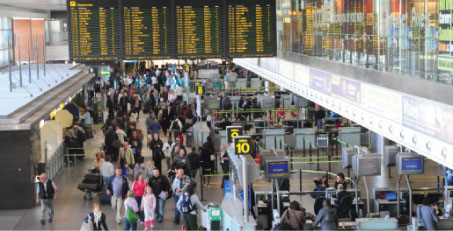
Siim Kallas, European Commission Vice President Responsible for Transport: “Transport 2050 is a roadmap for a competitive transport sector that increases mobility and cuts emissions. We can and we must do both.”
European Commission Vice President responsible for Transport, Siim Kallas launched the much-anticipated White Paper, which was greeted warmly by many, in March. The aim is to create a Single European Transport Area with more competition and a fully integrated transport network that links the different transport modes. Speaking at the launch, he said: “Curbing mobility is not an option. Nor is business as usual. Action cannot be delayed, infrastructure takes many years to plan and build. Trains, planes and ships last for decades. So the choices we make today will determine the shape of transport in 2050. That’s why we are acting now to achieve a transformation of Europe’s current transport systems. We need a fully integrated Single European Transport Area by 2050, at the service of business, enterprise and citizens across the continent.”
The European Commission invited the views of industry stakeholders on the measures that should be considered in preparation of the White Paper. Two High Level Stakeholder conferences took place – the second in November 2009.
ACI EUROPE issued a Position Paper on the Future of Transport, which presented three key messages: Aviation provides a unique and irreplaceable contribution to society – and in particular to the European economy; aviation needs to grow and this growth is compatible with the EU’s ambitious environmental objectives; and aviation needs an industrial policy at EU level focused on the reduction of regulatory-induced costs and new business opportunities. Kallas attended the January meeting of the ACI EUROPE Board, with discussions on the White Paper high on the agenda.
The White Paper outlines a series of ambitious targets in order to achieve the twin objectives of increasing mobility and reducing emissions. The headline figure is the aim to reduce carbon emissions generated by Europe’s transport system by 60% by 2050. Key goals on the road to achieving this overall target include no more conventionally-fuelled cars in cities; 40% use of sustainable low carbon fuels in aviation and at least a 40% cut in shipping emissions; and a 50% shift of medium distance freight journeys – defined as 300km and beyond – from road to rail and waterborne transport.
Other key targets are that by 2050 the majority of medium-distance passenger transport should go by rail, while by the same year all core network airports should be connected to the rail network, preferably high-speed rail.
Capacity challenge
Kallas said: “Transport 2050 is a roadmap for a competitive transport sector that increases mobility and cuts emissions. We can and we must do both. The widely held belief that you need to cut mobility to fight climate change is simply not true. Competitive transport systems are vital for Europe’s ability to compete in the world, for economic growth, job creation and for peoples’ everyday quality of life.”

The introduction of a Performance Scheme is aimed at increasing the performance of air navigation services in four key performance areas: safety, environmental targets, cost efficiency and flight efficiency.
The White Paper recognises that the lasting success of the European aviation market is dependent on the ability to tackle the capacity challenge and its negative impacts on the economy, passenger experience and delays. Long-term trends indicate capacity constraints on the ground and in the sky. EUROCONTROL figures highlight that despite a 41% increase in airport capacity between 2007 and 2030, 11% of demand will go unaccommodated in the best-case scenario, and 25% in the worst-case.
The White Paper states: “Whilst for certain airports there is a need for additional infrastructure, some congestion problems can be tackled by a system of slot allocation.” It also calls for greater intermodality, with better integration between air and rail. However, such measures alone cannot address congestion.
A key goal is the complete modernisation of Europe’s air traffic control system by 2020, delivering the Single European Sky (SES) and providing shorter and safer journeys, and more capacity. Events such as last year’s volcanic ash crisis emphasise the importance of better-integrated EU airspace.
SES aims to triple capacity, halve ATM costs per flight, improve safety by a factor of 10, and reduce the environmental impact of each flight by 10%. Under the initiative, a Network Manager function will be created to manage resources from a pan-European perspective; Functional Airspace Blocks (FABs) are being established to optimise the provision of air navigation services; while the introduction of a Performance Scheme is aimed at increasing the performance of air navigation services in four key performance areas: safety, environmental targets, cost efficiency and flight efficiency. The White Paper states that: “Delivering the SES within the agreed milestones is of the utmost importance for the future of European aviation.” The SES initiative will replace a national, fragmented approach with a truly European framework, with cooperation between Member States, European institutions, EUROCONTROL and other industry stakeholders.
The aim, by 2020, is also to complete the European Common Aviation Area of 58 countries and 1 billion inhabitants, which would create a truly integrated aviation market covering the EU and its closest regions. It would also provide unified regulatory approaches in areas such as safety and security.
Industry reaction
The aviation industry reaction to the White Paper was broadly positive, with recognition of the importance of transport to Europe’s economy, job creation and the mobility of its citizens. ACI EUROPE supports the vision outlined in the White Paper, particularly the acknowledgement that infrastructure shapes mobility, and also the challenging targets to reduce total transport carbon emissions by 60% by 2050 and to see the 40% use of sustainable low carbon fuels in aviation.
Indeed, Europe’s airports are already notably proactive in addressing carbon emissions. ACI EUROPE’s successful Airport Carbon Accreditation programme has already certified 43 airports in 18 European countries, welcoming over 600 million passengers a year.
However, ACI EUROPE also cautioned against unrealistic expectations. Olivier Jankovec, Director General, commented: “Improved intermodality will provide better mobility, but it will not solve the airport capacity crunch. Independent forecasts clearly indicate that demand for aviation in Europe will nearly double by 2030. They also warn that the extensive rail developments announced will only absorb 0.5% of the total demand for air transport. Given the ever-increasing difficulties and uncertainties that Europe’s airports face in seeking expansion approvals, the blunt reality of unprecedented congestion will sneak up on us very quickly. Europe’s airports need their licence to grow!”

The White Paper recognises that the lasting success of the European aviation market is dependent on the ability to tackle the capacity challenge, and its negative impacts on the economy, passenger experience and delays.
He added: “Transport 2050’s ambitions for a Single European Transport Area are to be applauded, but I cannot stress enough how urgently we need action on its call for an approach to resolving the airport capacity crunch. Without it, European air transport of all types will be compromised and passengers will suffer significant disruption.”
While the Association of European Airlines (AEA) did not publically react, the European Regions Airline Association (ERA) responded positively. Mike Ambrose, Director General, ERA, said: “It is greatly encouraging that the White Paper states ‘curbing mobility is not an option’. We see the promotion of air transport as a logical consequence. Europe’s air transport system is a driver for Europe’s international competitiveness and the sustainable, increased mobility of its citizens, especially those in Europe’s regions for whom international connectivity is vital.”
While the goals of Transport 2050 are commendable, it is clear that they cannot be achieved without urgent action to address the airport capacity crunch. This is not just an issue for airports; in the context of increased global competition, lack of capacity will result in congestion and disruption with wider implications for both Europe’s mobility and carbon emissions. The European Commission will address the issue of airport slots in its forthcoming ‘airports package’ due in the autumn. Indeed, they put out a press release as Airport Business was going to press, stating that better use of airport slots could allow the European airport network to accommodate an additional 28 million passengers. As promising as this may sound to some, it only amounts to a small gain, through better use of a scarce resource. The issue of airports slots does not hold all the answers to the airport capacity crunch. The cold reality reinforced by Transport 2050 is that, more than ever, airports require their licence to grow







